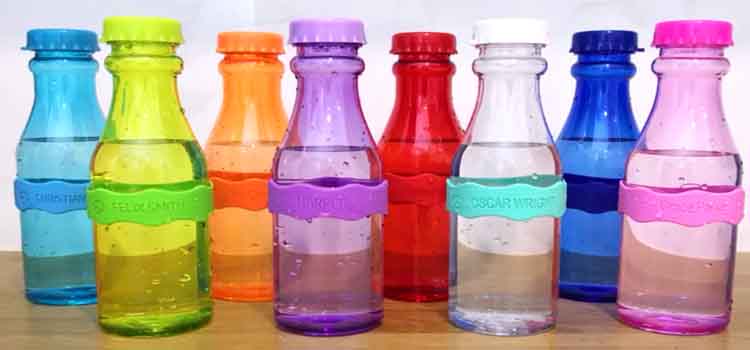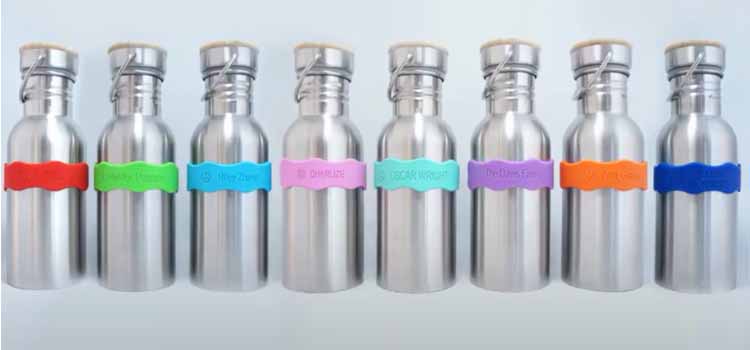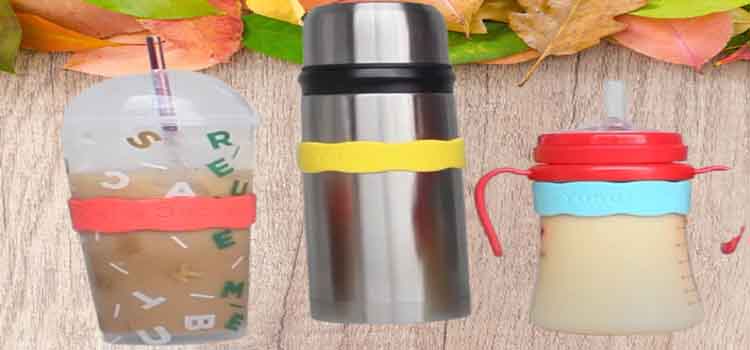As an Amazon Associate I earn from qualifying purchases.

Labeling silicone bottles can be a practical way to stay organized, especially for busy parents or travelers. Whether you’re storing baby formula, toiletries, or homemade sauces, knowing how to label silicone bottles effectively ensures clarity and reduces mix-ups.
A need in homes, gyms, and outdoor activities, silicone bottles have exploded in popularity because to their eco-friendliness, flexibility, and durability. The variety of their applications, however, calls for cautious labeling. Organization is just one aspect of labeling; safety, personalization, and efficiency are three more.
When a lot of people are going to be using the same items, having clear labels makes it much easier to tell what’s in them, prevents accidental mixing, and speeds up the process. Whether you’re in the middle of a hot shower trying to separate your hair products or a hectic game trying to get the right sports drink, labels are a lifesaver.
This article explores the complexities of labeling silicone bottles, including important factors to keep in mind, methods to use, and recommendations to make the process easier while still meeting industry requirements and ensuring optimal quality.
Understanding Silicone and Label Compatibility
What is Silicone? Characteristics and Common Uses
Silicone is a synthetic polymer with several applications. Its main ingredients are silicon, a naturally occurring element, and oxygen. Silicone is a preferred material in many different applications due to its exceptional flexibility, durability, and heat resistance.
Everyday use of silicone is ideal. Medical devices, personal care items (like pacifiers for infants and foldable water bottles), and kitchenware (like spatulas and baking moulds) all make use of it due to its hypoallergenic qualities. Its resistance to bacteria and mould growth makes it an ideal material for products that adhere to stringent hygiene standards.
Challenges of Labeling Silicone Materials
Silicone has many applications, but determining its identity can be challenging. Most adhesives have trouble adhering to silicone’s surface because it is not porous. Labels frequently come off, fade, or don’t stay very well in the first place.
Extreme temperatures and dampness are two environmental conditions that can aggravate these problems and reduce the longevity and visibility of labels. This can be especially troublesome in the food and beverage sector and medical contexts, where safety and compliance labeling are crucial.
Overview of Different Types of Labels Suitable for Silicone
To overcome these challenges, specific types of labels have been developed:
- Adhesive Labels: These were made to be used with adhesives that stick better on silicone. They offer a reliable choice for labeling, but they require precise application and a prepared surface.
- Heat Transfer Labels: These labels integrate into the silicone at the molecular level by using heat to form a connection, guaranteeing a long-lasting, permanent label that won’t peel off.
- Silicone Ink Labels: Printing directly onto silicone with silicone-based inks can create a durable and wear-resistant label. Manufacturers often use this method for branding.
- Laser Etching: By altering the silicone’s surface with laser etching, high-contrast marks may be made permanently without compromising the bottle’s structural integrity.
Types of Labels for Silicone Bottles

Permanent Labels vs Removable Labels
Whether silicone containers are labeled permanently or removable is often dictated by their intended usage. When information has to stay intact for an extended period of time and is exposed to factors like water, oils, or chemicals, permanent labels are the way to go. These are usually utilized in medical settings or on frequently used and cleaned devices. Removable labels, on the other hand, provide flexibility, making them ideal for containers that must be recycled or whose contents change frequently, such as those found in kitchens or laboratories.
Printed Labels
Printed labels on silicone bottles can be attractive and functional, making them a popular choice for personal and commercial use.
- Techniques for Printing on Silicone: Printing directly on silicone necessitates specific processes to guarantee the ink adheres to the smooth surface. Screen printing with silicone-based inks is a widespread technique because it allows the ink to dry and adhere at the molecular level, assuring durability.
- Durability of Printed Labels: These labels can survive situations with heat and moisture and are highly resilient and fading-resistant. However, the kind of ink and printing method utilized have a significant impact on the print quality.
Embossed Labels
Embossed labels create a raised design on the silicone surface, offering a tactile advantage over printed labels.
- Embossing Silicone involves pressing a mould with the desired design onto silicone under high heat and pressure. The surface structure changes to generate a permanent elevated pattern.
- Aesthetic and Functional Benefits: Not only do embossed labels enhance the grip of silicone bottles, but they also add a unique visual and tactile element that can enhance brand recognition and user experience.
Engraved Labels
Engraving provides a permanent labeling solution that directly cuts or etches designs into the silicone.
- Laser Engraving vs. Mechanical Engraving: Laser engraving achieves precision and consistency by vaporizing material. Mechanical engraving requires cutting silicone with a tool, which is slower and less uniform.
- Longevity and Wear Resistance: Engraved labels are incredibly durable, making them suitable for silicone bottles used in harsh conditions. They are immune to fading, peeling, and wear.
Stickers and Adhesives
Stickers are a versatile and economical choice for labeling silicone bottles, but they require careful adhesive selection to ensure effectiveness.
- Adhesive Types that Work Best on Silicone: Adhesives made from silicone or acrylic bases tend to adhere better to silicone surfaces, creating a stronger bond more resistant to environmental factors.
- Tips for Applying and Removing Stickers: The surface of the silicone bottle should be clean and dry for optimal adhesion. Applying heat can soften the adhesive, allowing for easier removal without leaving residue.
Step-by-Step Guide How to Label Silicone Bottles

Proper labeling of silicone bottles ensures that they are functional and adhere to safety standards and personal preferences. This guide outlines the steps to apply labels effectively, ensuring they last as long as the bottles themselves.
Preparing the Silicone Surface for Labeling
- Clean the Surface: To start, wipe the silicone bottle off with warm water and a little dish soap to remove any residue, oil, or debris. This step is crucial for ensuring that the label adheres appropriately.
- Dry Thoroughly: After cleaning, dry the surface completely with a lint-free cloth. Any moisture left on the bottle can prevent the label from sticking.
- Use an Alcohol Wipe: For extra cleanliness, wipe down the area where the label will be placed with an alcohol wipe. It will help remove any residual soap or oils and improve adhesion.
Applying Printed Labels
- Select the Right Adhesive: Choose a label with an adhesive that sticks to silicone surfaces. This might be a silicone or acrylic-based adhesive that can handle the bottle’s flexibility and texture.
- Position the Label: Carefully position the label on the silicone bottle. Once the position is set, press the label firmly, starting from one side and smoothing out any air bubbles.
- Secure the Bond: Press the label against the silicone for a few seconds to guarantee adhesion. Use a low-setting heat gun to reheat the label and gently enhance the adhesive bond for longevity.
DIY Techniques for Embossing at Home
- Create a Mold: You can create a simple mould using high-density foam or carve your design into a wood block.
- Heat the Mold and Press: For embossing, heat the mould slightly using a heat gun and press it firmly against the silicone bottle. Hold it in place until the design is imprinted and the area cools.
- Cooling: Allow the silicone to cool completely before removing the mould to ensure the embossed design sets properly.
Best Practices for Engraving Silicone
- Choose Your Method: Based on the precision and depth of design required, choose between laser engraving and mechanical engraving.
- Set Up the Engraver: Configure the engraving machine according to the manufacturer’s instructions, adjusting the silicone settings, which may differ from those for other materials.
- Test on a Sample: Always test the engraver on a sample piece of silicone first to ensure the settings are correct and the design comes out as expected.
- Execute the Engraving: After you’re happy with the settings, proceed to etch the silicone bottle, making that the region remains still and steady.
Maintenance Tips to Ensure Label Longevity
- Avoid Harsh Chemicals: Clean the labelled bottle with mild cleaning solutions to avoid weakening the adhesive or damaging the label.
- Regular Checks: Periodically check the label for signs of wear or peeling. If a label starts to peel, replace it promptly to prevent moisture or dirt from undermining the adhesive.
- Proper Storage: Store silicone bottles in cool, dry place away from direct sunlight, which can fade printed labels and weaken adhesives over time.
Creative Labeling Ideas and Inspiration(Label Silicone Bottles)

Creating visually appealing and functional labels for silicone bottles can enhance their usability and aesthetic appeal. Here’s how you can infuse creativity into your labelling efforts, whether for personal use, gifts, or commercial products.
Design Tips for Attractive and Functional Labels
- Maximize Contrast: Use high-contrast color combinations to ensure text and graphics are easily readable against the silicone backdrop. Black on white or vice versa are classic choices that offer visibility and readability.
- Keep It Simple: An uncluttered label usually blends in better than a clean, simple design. If you want your label to stand out on smaller bottles, choose a sans-serif typeface and keep the color palette basic.ler bottles.
- Incorporate Functionality: Include icons or symbols that quickly convey the bottle’s contents or purpose. For instance, a sunscreen bottle might feature a sun icon, while a water bottle used for sports might show a hydration droplet.
- Reflect the Bottle’s Use: Design labels that reflect the environment in which the bottle will be used. For example, bottles intended for outdoor use should have durable, weather-resistant labels with vibrant colours that stand out in natural settings.
Using Colors and Graphics to Personalize Labels
- Personalize with Color: Choose colors that reflect the user’s personality or preferences. Professional or personal care goods may benefit from more muted tones, whilst children’s things might benefit from more vibrant colors.
- Graphic Elements: Add custom graphics that relate to the bottle’s contents or the user’s interests. For instance, botanical illustrations can adorn essential oil bottles, or athletic graphics can enhance gym water bottles.
- Thematic Designs: Adopt themes for special occasions, such as floral patterns for spring or festive motifs for holidays. This approach personalises the bottle and makes it a great gift or seasonal item.
Case Studies: Successful Labeling Projects
- Eco-Friendly Brand Launch: A firm sold silicone-bottled eco-friendly shampoos with earth-toned, biodegradable labels to promote sustainability.Natural imagery and clear label design make the product line stand out on shelves and attract eco-conscious buyers.
- Customized Water Bottles for Events: For a corporate event, a firm customized silicone water bottles with labels featuring the event logo and date, along with a QR code linking to digital content related to the event. This enhanced brand engagement and provided a valuable keepsake for attendees.
- Sports Team Merchandise: A sports team used silicone bottles as part of their merchandise, employing the team’s colours and logo in the label design. The functional design included a textured grip area around the label to ensure the bottles were practical during intense activities.
Troubleshooting Common Labeling Challenges(Label Silicone Bottles)
Labeling silicone bottles can sometimes lead to issues such as peeling, fading, or non-adherence to the labels. Understanding how to address these challenges can enhance the durability and effectiveness of your labeling solutions, ensuring they remain functional and attractive over time.
Dealing with Peeling or Fading Labels
- Choose the Right Materials: Select high-quality labels designed for silicone surfaces to prevent labels from peeling or fading. Look for labels that are waterproof, UV-resistant, and made with durable adhesives.
- Proper Application: Before applying the label, ensure the silicone surface is clean and free from oils or residues. Using a primer designed for silicone can also improve adhesion.
- Protective Overlays: A translucent protective overlay can protect the label from sun and moisture damage, which can fade and peel.
Solutions for Non-Adhering Labels
- Surface Preparation:Clean the bottle with isopropyl alcohol to eliminate contaminants that might hinder label adherence..
- Adhesive Selection: Use adhesives formulated explicitly for low-energy surfaces such as silicone. These adhesives are stronger and more capable of bonding with the silicone’s slick surface.
- Heat Application: For specific labels, applying a small amount of heat after placing the label on the silicone can activate the adhesive further, creating a stronger bond.
Addressing Environmental Impact and Label Disposal
- Eco-Friendly Labels: Choose labels made from sustainable, biodegradable materials or those certified by environmental standards. This will reduce your environmental footprint and support eco-friendly disposal.
- Recycling Tips: Educate users on adequately removing and disposing of labels.Make sure to include advice on how to remove non-biodegradable labels before recycling the silicone container.
- Innovative Materials: Try recyclable paper, plant-based polymers, or water-soluble labels.
Conclusion (How to Label Silicone Bottles)
We have discussed various topics related to labelling silicone bottles in this extensive tutorial, from surface preparation and label type selection to label application techniques and typical problems. Important methods, including printing, embossing, and engraving, provide various options to make appealing and long-lasting labels suited to specific applications and settings.
You can ensure your labelled silicone bottles are long-lasting, aesthetically pleasing, and satisfy your particular needs by adhering to this guide’s recommendations and best practices.
FAQs (How to Label Silicone Bottles)
Printing directly on silicone bottles at home is typically not feasible due to specialized equipment and ink requirements.
Best practices for labelling silicone bottles for outdoor use include using weather-resistant materials, UV-resistant inks, and proper adhesion techniques.
Yes, eco-friendly label options for silicone bottles include biodegradable paper labels, recyclable plastics, and plant-based adhesives.
To ensure labels stay on in extreme temperatures, use adhesive specifically designed for temperature fluctuations and test them under varied conditions.
Labels made of silicone adhesive or those specifically designed for silicone surfaces are suitable for adhering to silicone bottles.
Label silicone daycare items with waterproof, dishwasher-safe labels or use silicone bands with written or engraved identifiers.
Amazon and the Amazon logo are trademarks of Amazon.com, Inc, or its affiliates.
Leave a Reply